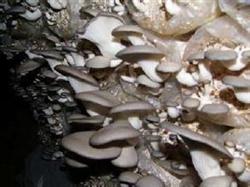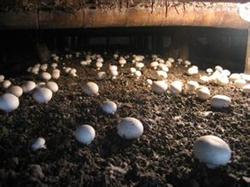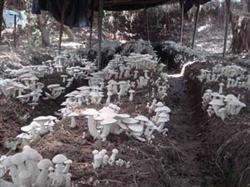Cultivation Technique of Mushroom at High Temperature

Mushroom is a kind of traditional edible mushroom that people generally like, but the general variety is Agaricus bisporus, and the temperature of mushroom production is about 16 ℃. It can only be seen in the market in autumn, winter and early spring. The high temperature mushroom variety introduced by Zhangjiagang Edible Mushroom Technical Popularization Station in Zhangjiagang City, Jiangsu Province in 1998 is Agaricus tetrasporus with a mushroom temperature of 26-31 ℃. The fruiting body still grows well when the temperature is as high as 26 ℃ in July and August, and maintains continuous batch production capacity, which completely changes the history of no fresh mushrooms on the market in summer, and makes the annual cultivation and production of mushroom farmers become a reality. The following is a brief introduction to the cultivation techniques of high temperature mushrooms. 1 strain production 1.1 strain high temperature mushroom Xindeng 96 was introduced from the Mushroom Research Institute of Hangzhou Changqing Health Food Co., Ltd. The mother seed of the culture medium is PDA medium, and the original seed and cultivated seed are wheat grain medium with a ratio of 98% wheat grain and 2% calcium carbonate. After bottling, sterilization, inoculation, and culture, the finished bacteria are made and supplied to all kinds of plants. (2) the culture material formula of cultivation technique 2.1 was conventional rice straw fermentation material, and the specific formula was (in terms of 111.1m2 area): Rice straw 2000kg, vegetable cake 140kg, calcium superphosphate 100kg, gypsum 100k, lime 75kg urea 40kg. 2.2 the composting fermentation of the culture material was carried out by secondary fermentation, which was made outdoors for about 15 days, turned the pile 3 times for 4 times, then went into the mushroom room or shed to heat up, heated to about 65 ℃ and kept for 6-8 hours, then lowered the temperature to 52 ℃ for 3 days, and carried out post-fermentation. 2.3 Management of sowing and inoculation period after the second fermentation, the doors and windows were opened for ventilation. When the temperature of the culture material dropped to 30 ℃, the second sowing method was used. That is, first sprinkle the amount of bacteria on the surface of the material, then turn the bacteria into the material, then sprinkle the remaining 1 of the bacteria on the surface of the material layer, and gently pat it flat with a plank. The sowing rate is 2 bottles of wheat seeds or 3 bottles of cotton husks per square meter. After sowing, it is mainly to close the window to send bacteria, and it can be properly ventilated when the temperature is high. 2.4 cover the soil when the hyphae basically grow to the bottom of the material layer. Before covering the soil, you must thoroughly check whether there are latent miscellaneous bacteria and pests. Once found, measures must be taken to eliminate them before the covering. Fine mud bran soil or river mud bran soil was used for soil mulching. The ratio of rice bran to soil was 20:1. Formaldehyde was sprayed before disinfection. The moisture content was controlled by pinching and spreading, and the pH8 was about. Cover soil thickness 3~4cm, spray water 2.25kg/m2 or so after covering soil, close the window, fill soil when mycelium emerges in the gap of soil layer. 2.5 about 15 days after the mushroom management was covered with soil, the hyphae began to twist into primordia, and ventilation and water spraying were carried out to keep the bed moist all the time. When soybean-sized mushroom buds appeared in the soil seams, water was sprayed in time to promote the formation of fruiting bodies. At the same time, the air humidity in the mushroom house (mushroom shed) is high, reaching 85%-90%. In the whole process of cultivation and management, the relationships among water spraying, ventilation and moisturizing should be handled correctly. Mushrooms should be harvested in time, neither too early nor too late. 2.6 if pests are found in pest control cultivation, yellowish brown spots will appear on the surface of mushrooms. After the end of a tide of mushrooms, spray the bed with enemy killing 4mL and water 25kg, and usually hang cotton balls dipped in dichlorvos on both sides of the aisle in the mushroom shed to drive away adults. At the same time, increase the ventilation rate, so that water does not accumulate in the mushroom body, resulting in discoloration and rotten spots.
- Prev

Improved Technique of Mushroom Cover
Covering soil is an important link in the cultivation process of mushroom, and the characteristics of covering soil material directly affect the yield and yield of mushroom. Especially, the water holding capacity and water holding capacity of covering soil have great influence on yield. In recent years, the selection and improvement of covering materials have been carried out continuously in various places. From the simple use of vegetable soil, river soil to...
- Next

Four kinds of mushroom fertilizer
First, mushroom root soup. The mushroom feet cut off by picking mushrooms, boiled with water for 5 minutes, clarified and sprayed with 10 times water can promote the growth of young mushrooms. Second, the leaching solution of culture material. The sun-dried fermentation medium is boiled with water, filtered to extract juice, and sprayed with 10 times of water and 10% calcium carbonate, which can prolong the mushroom emergence time of the bacteria bed.
Related
- Fuxing push coffee new agricultural production and marketing class: lack of small-scale processing plants
- Jujube rice field leisure farm deep ploughing Yilan for five years to create a space for organic food and play
- Nongyu Farm-A trial of organic papaya for brave women with advanced technology
- Four points for attention in the prevention and control of diseases and insect pests of edible fungi
- How to add nutrient solution to Edible Fungi
- Is there any good way to control edible fungus mites?
- Open Inoculation Technology of Edible Fungi
- Is there any clever way to use fertilizer for edible fungus in winter?
- What agents are used to kill the pathogens of edible fungi in the mushroom shed?
- Rapid drying of Edible Fungi

